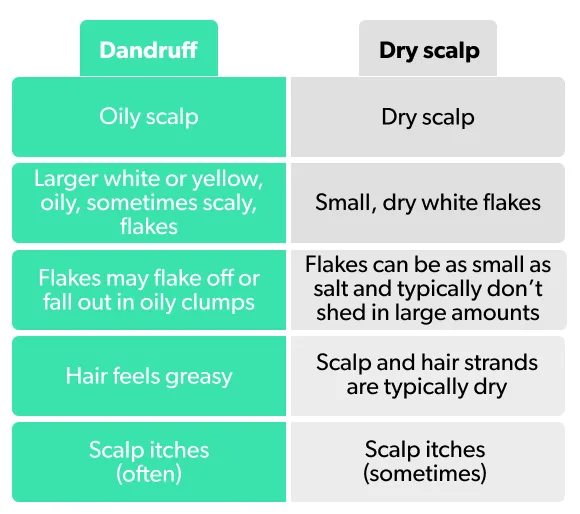Here's what we'll cover
Here's what we'll cover
Here's what we'll cover
If you look into a mirror and notice flakes on your scalp, there’s a chance you have dandruff. Or those flakes could be caused by a dry scalp. Both are common conditions—about half of American adults live with dandruff, to give you an idea—but each condition has different treatment approaches. If it’s dry scalp, dandruff treatments won’t help and may worsen those flakes.
To help sort out the differences between dandruff and dry scalp, we’ve enlisted the help of Jeffrey S. Fromowitz, MD, FAAD, a board certified dermatologist who practices general, cosmetic, and pediatric dermatology in Boca Raton, Florida.
Differences between dandruff and dry scalp
While you might think a flake is a flake, Dr. Fromowitz says there are some key differences between dandruff flakes and dry scalp flakes.
“Dandruff is a result of too much oil on the scalp, and the main side effect is flaking that tends to be larger pieces of skin that are oily in nature,” he adds. “Dry scalp, on the other hand, is usually a fine, very dry scale that is much smaller in size.”
Dr. Fromowitz also says you can usually feel the difference: “Due to the excess oil involved with dandruff, you may experience oily or greasy-feeling hair. This may also be accompanied by an itchy scalp, though a dry scalp may also cause persistent itching.”
Here’s what to look for when trying to figure out if those flakes are caused by dandruff or a dry scalp:

Flakes—whether from dandruff or dry scalp—can be very distressing, but Dr. Fromowitz assures us that “flakes actually reveal a lot about what’s going on if you take a closer look at them.”
What’s going on in the case of dandruff versus dry scalp? Figuring out the causes of each can help you figure out the right treatments for you.
What is dandruff?
Most cases of dandruff are typically milder versions of a skin condition called seborrheic dermatitis, which can be found on oily skin areas around the body. A common fungus called Malassezia—found on everyone’s skin—consumes these oils and creates byproducts that can irritate the skin (Saunte, 2020).
There are different types of Malassezia. If you’re sensitive to this fungus or any of the common bacteria found on the scalp, you may experience irritation and inflammation, even if it’s mild and hardly noticeable. Inflammation triggers skin cell turnover, which causes the dead skin cells to fall off as dandruff flakes (Li, 2022).
“Men are often diagnosed with dandruff more often than women, and it’s believed this is because of the impact of male hormones, which increase sebum and natural oil production,” says Dr. Fromowitz. He also says certain medical conditions—like Parkinson’s disease or HIV—can make dandruff more likely. But anyone can have a sensitivity to Malassezia or other irritants. The irritants damage the skin barrier in certain people, making it more susceptible to inflammation and dandruff (Saunte, 2020).
What is dry scalp?
Unlike classic cases of dandruff, flakes linked to dry scalp are caused by a lack of moisture in the scalp. You may notice dry flakes and dry skin, but what’s causing that dryness may require some detective work.
“Dry scalp is generally multifaceted, so there’s more than one cause of the issue,” says Dr. Fromowitz. “Some people, for example, are simply genetically predisposed to dry skin.”
Is it genetic or is there something in your environment or daily routine that’s dehydrating your scalp? Here’s a look at some common causes of dry skin and a dry, flaky scalp (Gade, 2021; Turner, 2012):
Frequent hair washing, especially with hot water
Hairstyling with heat
Hair products that dry out the scalp
Dry air or low humidity (often from high heat or air conditioning)
Other skin conditions such as scalp eczema
Health conditions such as kidney disease or diabetes
Age: skin, including the scalp, loses moisture as you age
Not drinking enough water
Nutritional deficiencies, such as low intake of healthy fatty acids (Borda, 2015; Balic, 2020)
Treating dandruff and dry scalp
Now that we see that dandruff and dry scalp are quite different, it makes sense that we treat them differently.
Treating dry scalp
The first step to treating dry scalp is checking the products you’re using to make sure these aren’t contributing to your condition.
“If it’s a personal care product that’s stripping out too much moisture, it can be treated with gentle shampoos and hair products,” says Dr. Fromowitz. “Avoiding over-processing hair with chemicals and high heat dryers can help. Use a conditioner and apply a scalp oil as a moisturizer to hydrate the skin.”
He also suggests adding moisture to your environment, such as a humidifier: “Any intervention that helps hydrate the skin will help.”
In addition to laying off daily hair washing and harsh products, research shows hydration and healthy skin starts from within. Drinking plenty of water is a priority. Also, make sure you’re getting healthy polyunsaturated fatty acids in your diet. Research shows omega-3 fatty acids found in fish, shellfish, nuts, seeds, plant oils, and fortified foods can improve overall skin health and skin hydration (Thomsen, 2020; NIH, 2021).
Omega-3 fatty acids have the added benefit of reducing inflammation, which has also been shown to improve dandruff linked to seborrheic dermatitis (Huang, 2018).
Treating dandruff
Treating classic cases of dandruff is more straightforward.
“Dandruff can be treated with over-the-counter or prescription products,” notes Dr. Fromowitz. “These include shampoos with zinc pyrithione (also called pyrithione zinc), coal tar, salicylic acid, selenium sulfide, and ketoconazole—ingredients that address multiple aspects of this condition.”
The primary treatments—usually in the form of an anti-dandruff shampoo—contain antifungal medications, like zinc pyrithione, and work by combatting the fungi linked to dandruff. The goal of scalp treatment is to reduce the overgrowth of Malassezia. These shampoos often contain salicylic acid as well, which exfoliates dead skin cells before they can flake off (Borda, 2015).
Research shows that standard antifungal dandruff treaments can bring scalps with an overabundance of Malassezia and bacteria back to a healthy balance (Schwartz, 2015).
“Everyone’s response to treatment is different, but you should see a significant improvement within two weeks of use,” adds Dr. Fromowitz. “Over-the-counter and at-home remedies such as tea tree oil are sufficient to completely resolve symptoms for many. It is only when these are insufficient that one needs to see a specialist.”
Beyond these OTC and prescription treatments, here are some lifestyle tips that may help:
Wash your hair regularly—Infrequent hair washing doesn’t cause dandruff. However, letting oil build up on your hair can provide a more favorable environment for Malasezzia and bacteria, allowing more dandruff to form (Borda, 2015).
Pay attention to hair care ingredients—A condition called contact dermatitis can cause redness, itching, and flaking of the skin, often caused by hair care products or hair processing. On the scalp, it can be confused with dandruff (Litchman, 2021).
Relieve stress—Studies have linked stress to increased problems with dandruff and other skin conditions (Bin Saif, 2018).
Add fruit to your diet—A healthy diet is key to fighting off a wide range of illnesses and conditions. When it comes to dandruff, one study showed that those who ate more fruit were 25% less likely to suffer from seborrheic dermatitis. While more research is needed, it’s another good reason to grab an apple (Sanders, 2019).
When to see a healthcare provider
In most cases, you won’t need to see a healthcare provider for a flaky scalp, whether the cause is dry skin or dandruff. The treatments listed above should do the trick. If they don’t work for you, though, it’s time to get some help.
If you have excessively dry skin that could be linked to an underlying medical condition, a healthcare provider may be able to help you figure out what’s causing the dryness. Keep in mind that dry skin is common, especially during the winter months, and many products can cause a dry scalp. It may help to stop using harsher products and boost your moisturizer usage to see how your skin reacts.
If dandruff is severe and extends beyond the scalp or you’re having a tough time controlling it, Dr. Fromowitz suggests seeking the help of a board-certified dermatologist:
“First and foremost, it is critical for your dermatologist to confirm the diagnosis and rule out other causes of flaking and related symptoms. And second, it is important for them to design the correct treatment protocol. This may involve checking for an underlying skin condition if nothing else has helped with your symptoms.”
DISCLAIMER
If you have any medical questions or concerns, please talk to your healthcare provider. The articles on Health Guide are underpinned by peer-reviewed research and information drawn from medical societies and governmental agencies. However, they are not a substitute for professional medical advice, diagnosis, or treatment.
References
Balić, A., Vlašić, D., Žužul, K., Marinović, B., & Bukvić Mokos, Z. (2020). Omega-3 versus omega-6 polyunsaturated fatty acids in the prevention and treatment of inflammatory skin diseases. International Journal of Molecular Sciences , 21 (3), 741. doi: 10.3390/ijms21030741. Retrieved from https://www.ncbi.nlm.nih.gov/pmc/articles/PMC7037798/
Bin Saif, G. A., Alotaibi, H. M., Alzolibani, A. A., Almodihesh, N. A., Albraidi, H. F., Alotaibi, N. M., & Yosipovitch, G. (2018). Association of psychological stress with skin symptoms among medical students. Saudi Medical Journal , 39 (1), 59–66. doi: 10.15537/smj.2018.1.21231. Retrieved from https://www.ncbi.nlm.nih.gov/pmc/articles/PMC5885122/
Borda, L., Seborrheic dermatitis and Dandruff: A comprehensive review. (2015). Journal of Clinical and Investigative Dermatology , 3 (2). doi: 10.13188/2373-1044.1000019. Retrieved from https://www.ncbi.nlm.nih.gov/pmc/articles/PMC4852869/
Gade, A. (2021). Xeroderma. [Updated Nov 21, 2021]. In: StatPearls [Internet]. Retrieved on Feb. 2, 2022 from https://www.ncbi.nlm.nih.gov/books/NBK565884/
Huang, T. H., Wang, P. W., Yang, S. C., Chou, W. L., & Fang, J. Y. (2018). Cosmetic and therapeutic applications of fish oil’s fatty acids on the skin. Marine Drugs , 16 (8), 256. doi: 10.3390/md16080256. Retrieved from https://www.ncbi.nlm.nih.gov/pmc/articles/PMC6117694/
Li, J., Feng, Y., Liu, C., Yang, Z., de Hoog, S., Qu, Y., et al. (2022). Presence of Malassezia hyphae is correlated with pathogenesis of seborrheic dermatitis. Microbiology Spectrum . doi: 10.1128/spectrum.01169-21. Retrieved from https://www.ncbi.nlm.nih.gov/pmc/articles/PMC8754105/
Litchman, G. (2021). Contact dermatitis. [Updated Sep 9, 2021]. In: StatPearls [Internet]. Retrieved on Feb. 2, 2022 from https://www.ncbi.nlm.nih.gov/books/NBK459230/
NIH, U.S. Department of Health and Human Services. (n.d.). Office of dietary supplements - omega-3 fatty acids. NIH Office of Dietary Supplements . Retrieved on Feb. 2, 2022 from https://ods.od.nih.gov/factsheets/Omega3FattyAcids-Consumer/
Sanders, M. G. H., Pardo, L. M., Ginger, R. S., Kiefte-de Jong, J. C., & Nijsten, T. (2019). Association between diet and Seborrheic Dermatitis: A cross-sectional study. Journal of Investigative Dermatology , 139 (1), 108–114. doi: 10.1016/j.jid.2018.07.027. Retrieved from https://pubmed.ncbi.nlm.nih.gov/30130619/
Saunte, D. M., Gaitanis, G., & Hay, R. J. (2020). Malassezia-associated skin diseases, the use of diagnostics and treatment. Frontiers in Cellular and Infection Microbiology , 10 . doi: 10.3389/fcimb.2020.00112. Retrieved from https://www.ncbi.nlm.nih.gov/pmc/articles/PMC7098993/
Schwartz, J. R., Henry, J. P., Kerr, K. M., Mizoguchi, H., & Li, L. (2015). The role of oxidative damage in poor scalp health: Ramifications to causality and associated hair growth. International Journal of Cosmetic Science , 37 , 9–15. doi: 10.1111/ics.12289. Retrieved from https://pubmed.ncbi.nlm.nih.gov/26574300/
Thomsen, B. J., Chow, E. Y., & Sapijaszko, M. J. (2020). The potential uses of omega-3 fatty acids in dermatology: A review. Journal of Cutaneous Medicine and Surgery , 24 (5), 481–494. doi: 10.1177/1203475420929925. Retrieved from https://pubmed.ncbi.nlm.nih.gov/32463305/
Turner, G. A., Hoptroff, M., & Harding, C. R. (2012). Stratum corneum dysfunction in Dandruff. Wiley Online Library . Retrieved on Feb. 2, 2022 from https://onlinelibrary.wiley.com/doi/10.1111/j.1468-2494.2012.00723.x










